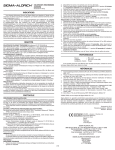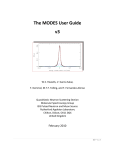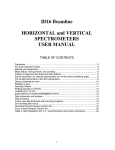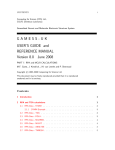Download User's Guide fast: Fast Absorption Simulation by TDDFT
Transcript
U s e r’ s
Guide
fast:
Fast Absorption Simulation by
TDDFT
Version 1.0
January, 2013
Ross Brown, C´edric Castagne, Olivier Coulaud, Dietrich Foerster, Peter
Koval.
Copyright (c) 2013
1
fast is Open Source software; you can redistribute it and/or modify it under the terms of
the CeCILL free software license agreement version 2. See the CeCILL FREE SOFTWARE
LICENSE AGREEMENT.
URL: http://www.cecill.info/licences/Licence_CeCILL_V2-en.html
Acknowledgements
It is a pleasure to thank Professor James Talman, University of Western Ontario, who kindly
donated important routines for 3j, 6j, 9j symbols and a fast Hankel transform. The ongoing
encouragement and advice of the siesta development team, particularly Alberto Garc´ıa, Institut de Ci`encia de Materials de Barcelona and Daniel Sanchez-Portal, Centro de F´ısica de
Materiales Donostia-San Sebasti´
an, and of Luc Giraud, Inria-Bordeaux Sud-Ouest, is gratefully
acknowledged. This work was supported by a.n.r. grant CIS 2007 NOSSI. —
2
Contents
1 About fast
4
2 Installation
5
2.1
Prerequisites . . . . . . . . . . . . . . . . . . . . . . . . . . . . . . . . . . . . . .
5
2.2
Compilation . . . . . . . . . . . . . . . . . . . . . . . . . . . . . . . . . . . . . . .
5
2.2.1
Compilation with Cmake . . . . . . . . . . . . . . . . . . . . . . . . . . .
6
2.2.2
Cmake work-around . . . . . . . . . . . . . . . . . . . . . . . . . . . . . .
7
Running fast . . . . . . . . . . . . . . . . . . . . . . . . . . . . . . . . . . . . . .
7
2.3
3 Detailed description of program options
7
3.1
General system descriptors . . . . . . . . . . . . . . . . . . . . . . . . . . . . . .
7
3.2
Input files
. . . . . . . . . . . . . . . . . . . . . . . . . . . . . . . . . . . . . . .
8
3.3
Output files . . . . . . . . . . . . . . . . . . . . . . . . . . . . . . . . . . . . . . .
8
3.4
Base compression parameters . . . . . . . . . . . . . . . . . . . . . . . . . . . . .
9
3.5
Spectrum parameters . . . . . . . . . . . . . . . . . . . . . . . . . . . . . . . . . .
10
3.6
Solver parameters . . . . . . . . . . . . . . . . . . . . . . . . . . . . . . . . . . . .
13
3.7
Fit parameters . . . . . . . . . . . . . . . . . . . . . . . . . . . . . . . . . . . . .
13
3.8
Potential parameters . . . . . . . . . . . . . . . . . . . . . . . . . . . . . . . . . .
14
4 Coupling fast to siesta via mpicpl
15
4.1
Compilation . . . . . . . . . . . . . . . . . . . . . . . . . . . . . . . . . . . . . . .
15
4.2
Coupling parameters . . . . . . . . . . . . . . . . . . . . . . . . . . . . . . . . . .
15
4.3
Example . . . . . . . . . . . . . . . . . . . . . . . . . . . . . . . . . . . . . . . . .
16
5 Troubleshooting
17
3
1
About fast
fast is a linear response time dependent density functional program for computing the electronic absorption spectrum of molecular systems. It uses an O(N 3 ) linear response method
based on finite numerical atomic orbitals and deflation of linear dependence in atomic orbital
product space. This version is designed to work with data produced by the siesta dft code.
The code produces as principal output a numerical absorption spectrum (complex part of the
polarisability, loosely called the polarisability below) and a list of transition energies and oscillator strengths deduced from fitting Lorentzians to the numerical spectrum. Considering the
absence of hybrid functionals in siesta and that concerning calculation of spectra, generalised
gradient Hamiltonians are not usually considered to be notably better than the local density
approximation, the present release of fast works only with LDA, which despite its limitations,
has provided useful results on the systems to which the present authors have applied it.
This Reference Manual contains descriptions of all the input, output and execution features of
fast, but is not intended as a tutorial introduction to the program. Potential users should consult
the papers listed below for details of the methods employed.
The code is written in Fortran 95 with dynamic memory allocation. It uses routines from
the BLAS, LAPACK and FFTW package (see http://www.fftw.org/) for all FFT routines. It
may be compiled for serial or parallel execution (under OpenMP, MPI and MPI+OpenMP).
Owing to licence related reasons, users should first obtain and install either the siesta code or
the standalone siesta XC exchange-correlation library ( http://www.icmab.es/siesta ) . The
present code includes two pieces of software under licence :
• Routines for numerical quadrature on the sphere, distributed through CCL
http://www.ccl.net/.
V.I. Lebedev, and D.N. Laikov “A quadrature formula for the sphere of the 131st algebraic
order of accuracy” Doklady Mathematics, Vol. 59, No. 3, 1999, pp. 477-481.
• A GMRES solver available at http://www.cerfacs/algor/Softs.
V. Frayss´e, L. Giraud, S. Gratton, and J. Langou, A set of GMRES routines for real
and complex arithmetics on high performance computers, CERFACS Technical Report
TR/PA/03/3, 2003.
Papers on fast.
Users of this code should include references [1–3] below in their publications, and in the userand programmers’-manuals describing their codes.
1 P. Koval, D. Foerster, O. Coulaud. Fast construction of the Kohn–Sham response function
for molecules, in ”Physica Status Solidi B”, February 2010, vol. 247, no 8, p. 18411848.
[DOI : 10.1002/PSSB.200983811], http://hal.inria.fr/inria-00457652/en.
2 P. Koval, D. Foerster, O. Coulaud. A Parallel Iterative Method for Computing Molecular
Absorption Spectra, in ”Journal of Chemical Theory and Computation”, 2010, vol. 6, no
9, p. 26542668 [DOI : 10.1021/CT100280X], http://hal.inria.fr/inria-00488048/en
4
3 Olivier Coulaud, Patrice Bordat, Pierre Fayon, Vincent LeBris, Isabelle Baraille, Ross Brown.
Extensions of the Siesta DFT code for simulation of molecules. Inria research report 8221
http://hal.inria.fr/hal-00787088
2
Installation
This section discusses configuration, installation and running the code on a Unix-like operating
system, such as Linux or Mac OS X.
2.1
Prerequisites
Before installing fast obtain and install the following :
• Fortran and C++ compilers (Intel version 12.x or higher / Gnu 4.2.1 or higher).
• CMake version 2.8.2 or higher and a working compiler. On Unix-like operating systems,
fast also requires Make.
• The siesta XC Exchange correlation library.
• The BLAS, LAPACK and FFTW libraries.
• MPI version 1.4.4 or higher if parallel execution is required.
• The gnu scientific library version 1.15 or higher is required.
N.B. Although fast is a parallel code, all the above routines are used in sequential mode in
the tddft code.
2.2
Compilation
The project is packaged under CMake (http://www.cmake.org). General information about
CMake, as well as installation of binaries and CMake source code is available from the CMake
homepage.
The first step is to get the source of TDDFT and uncompress it:
shell$ tar zxf FAST-1-0.tar.gz
shell$ cd fast
shell$ mkdir build
shell$ cd build/
5
2.2.1
Compilation with Cmake
Installation by itself is the fairly common CMake process:
shell$ cmake-gui ../
shell$ make
shell$ make test
shell$ make install
Options can be activated by setting flags during compilation. Several options must be set to
use cmake-gui interface. These options define library paths used in the code and the type of
implementation (sequential or parallel for example).
• CMAKE INSTALL PREFIX: should be set to the path of the installation directory
(i.e. prefix).
• FAST OPENMP: Activate (set ON, default: OFF), to compile the OpenMP version of
fast.
• FAST MPI: Activate (set ON, default: OFF), to compile the MPI version of fast. In
this case MPI variables and functions are accessed through module mpi rather than via an
include file. Moreover the compiler must be mpif90.
• FAST DISPLAY PROD: Activate (set ON, default: ON) to display all information
about orbital products.
• FAST CHECK NBITER GMRES: Activate (set ON, default: ON), to verify the
number of iterations in the gmres algorithm.
• FAST USE MKL: Activate (set ON, default: ON) to link fast with the Intel MKL
library. If disabled, linking to third-party librairies (BLAS, LAPACK and FFTW3) has
to be set manually, namely :
– FAST BLAS PATH: path to the BLAS library.
– FAST BLAS FLAGS: flags needed to link with BLAS.
– FAST LAPACK PATH: path to the LAPACK library.
– FAST LAPACK FLAGS: flags needed to link with LAPACK.
– FAST FFTW3 PATH: path to the FFTW3 library.
– FAST FFTW3 FLAGS: flags needed to link with FFTW3.
– FAST FFTW3 INCLUDE PATH: path to the include file for FFTW3.
• FAST SIESTA COUPLING: Activate (set ON, default: OFF) to enable coupling with
siesta through mpicpl. Requires FAST MPI options enabled.
• FAST PRINT SPECTRUM ITER: Activate (set ON, default: OFF) to active printout of spectrum and integral during each iteration.
6
2.2.2
Cmake work-around
If Cmake is unavailable on your system, a work-around with the Intel compilers, the mkl library
and openmp is :
shell$ mkdir build
shell$ cd build
shell$ CC=icc FC=ifort CXX=icpc cmake \
\
-D FAST OPENMP:BOOL=ON \
-D FAST USE MKL:BOOL=ON \
\
-D CMAKE INSTALL PREFIX:PATH=/usr/local/fast \
-D CMAKE BUILD TYPE:STRING=RELEASE \
-D SIESTA XC DIR:PATH=$HOME/Dev/src/nossi/siesta/bzr/Obj/SiestaXC \
-D GSL CONFIG EXECUTABLE:FILEPATH=/opt/intel/softs/bin/gsl-config \
../
followed by
shell$ make
shell$ make install
2.3
Running fast
Basic running of the code requires an input file of parameters and files pre-computed with
siesta, see the input section (3.2).
Run the code with the comand line
./bin/tddft input file name
where input file name is the name of the file of input parameters, see the next section.
3
Detailed description of program options
This section describes all the parameters that define a fast run, with their data types and
default values.
3.1
General system descriptors
SystemLabel (string): A single word (max. 20 characters without blanks) containing a
nickname of the system. This name is also the generic name of all SIESTA input files (see
input files section, 3.2).
iv (integer): Controls verbosity for debugging; default 0 (low); set to 1 or 2 for higher verbosity.
7
input directory (string): The name of the directory where fast reads all siesta files. Set to
’.’ to use the working directory.
Default: input
output filename (string): Generic name (less than 120 characters) for all output files. For
example ’calculation case1/case1’. N.B. The directory should be created before runing
fast, otherwise the code crashes with error (under the Intel compiler) forrtl: No such file
or directory.
Default: output/str SystemLabel where str SystemLabel is the string set in the SystemLabel keyword.
Default: 1
io units (string): Units of frequency for the spectra. Input of frequency limits will be interpreted according to this option. Output of absorption spectra depends on this option.
Allowed values : Rydberg, cm-1, Angstrom, Hartree, nm, eV.
Default: Rydberg
3.2
Input files
A fast tddft calculation needs information on the system from the underlying dft calculation,
such as the geometry, the molecule wavefunctions, the pseudo potentials, the Hamiltonian and
overlap matrices etc. When not compiled to be run coupled to siesta via mpicpl, the fast
program gathers this information from the .DIM (geometry), .WFSX (packed wavefunctions),
.HSX(Hamiltonian,. . . ) and .PLD (charge density) siesta output files. To generate these files
the following two keywords must be present in the input file of SIESTA.
COOP.Write
WriteDenchar
.true.
.true.
The reader is referred to the siesta manual for further details.
3.3
Output files
input outputFileName polarizabilitySpectra.txt : The polarisability spectra. On each line : ω,
P (ω) (unpolarised i.e. sum of components), the x, y and z components. Lines starting with
a ’#’ show frequencies where there was a convergence problem or a negative polarisability.
input outputFileName dipol core.txt : the dipole core.
input outputFileName numof iter.txt : iterations needed to achieve convergence at each frequency for.
input outputFileName OddFrequency.txt : frequencies where the GMRES had difficulty.
In additon, if the Lorentzian fit to the numerical spectrum is activated :
8
input outputFileName transitions.txt : transition energies and the oscillator strengths.
input outputFileName lorentzians.txt : spectrum and the fitted spectrum at the frequencies
at which the polarisability was calculated.
input outputFileName modelledSpectrum.txt : fitted spectrum on a set of uniformly spaced
points, not necessarily those where the spectrum was computed.
3.4
Base compression parameters
At the heart of the fast program is the suppression or reduction of linear dependence in the
space of atomic orbital products used to describe the linear response (see papers 1 & 2 above).
Dominant products are defined by diagonalisation of the Couloomb metric in the space of products of atomic orbitals and retention of a sub-set of eigenvectors with the largest eigenvalues.
Several parameters control this process. Default values below have produced good results on
test systems, but users are encouraged to experiment.
eigmin local (real): Defines the threshold for eigenvalues of the metric of orbital products on
the same atom. Eigenvectors with smaller eigenvalues will be dropped in the computation
of the sigma-matrices and spectrum.
Default: 1.0 E-3
eigmin bilocal (real): Defines the threshold for eigenvalues of the metric of orbital products on
different atoms. Eigenvectors with smaller eigenvalues will be dropped in the computation
of the sigma-matrix and spectrum.
Default: 1.0 E-4
use eigmin local H (boolean): If .true. use a special threshold for hydrogen local products.
Default: .false.
eigmin local H (real): Threshold for hydrogen local products.
Default: eigmin local/10
use rcut (boolean): If .true., drop orbital products for pairs of atoms with small geometrical
orbital overlap, using criterion rcut set with the rcut keyword.
Default: .false.
rcut (real): Allows suppression of further products, based on the thickness of the lens shaped
region defined by the intersection of the largest orbitals on a pair atoms A and B. All
orbital products of a pair of atoms are dropped from the metric when
Rmax (a) + Rmax (b) − distance(a, b) < rcut ,
where Rmax (a) (resp. b)is the radius of the support of all atomic orbitals on atom A (resp.
B).
Default: 3.0 U where U is the unit of length for atomic positions the atoms stored in the
siesta .DIM output file read by fast.
9
write all eigens (boolean): If .true. write all eigenvalues for all pairs of atoms in separate
files. File names are constructed according to the rules :
For species the file name is construct
input_outputFileName //’_eigen_’ // species //".txt")
For atoms pairs (e.g. atoms n1 and n2) the eigenvalues are stored in file
input_outputFileName//’_eigen_’ // n1n2,//".txt"
Default: .false.
3.5
Spectrum parameters
The basic task accomplished by fast is to compute the absorption spectrum P (ω) of a molecular, i.e. finite system at a set of frequencies ω in some user-defined interval [ωmin , ωmax ]. Such
a spectrum is not in itself very useful since it is a set of discrete resonances with width and
heights dependent on the regularisation parameter . Paper 3 therefore describes an adaptative algorithm to extract transition frequencies, ΩI , and oscillator strengths, fI , from the raw
polarisability spectrum calculated by fast. The algorithm proceeds by a two-tier iteration.
In the top level iteration, (i) the number of frequency points used (and polarisabilities, P (ω)
computed, beware the cost in CPU time), is increased by a constant fraction; or (ii) the regularisation parameter is reduced by a step towards its target value; or (iii) both changes are
made. In between top level iterations, the lower level iteration bears on the distribution of
the frequency points. It uses the current spectrum to cluster the frequency points around the
resonances, which improves the estimates of the a sum of Lorentzians to the spectrum.
Tier-two clustering is iterated until the resonance parameters ΩI and fI are stable, after which
tier-one update of the number of frequency points and the regularisation parameter, or both,
are updated, and the cycle continues until convergence of the resonances between iterations. A
combination of keywords provided at the end of this section can be used to invoke only tier two
iterations.
The following parameters control the frequencies where fast computes the optical polarizability
P (ω), and how the adaptive algorithm described in paper 3 extracts the transition frequencies
and oscillator strengths.
omega min (real): Lower bound of the frequency range.
Default: 0.02 in io units
omega max (real): Upper bound of the frequency range.
Default: 0.4 in io units
N.B. The default values of omega min and omega max are suitable for the visible
spectral region if io units are Rydbergs.
10
eps units (string): Units for the regularisation parameter ε.
Allowed values : Rydberg, cm-1, Angstrom, Hartree, nm, eV.
Default: Rydberg
freq eps (real): Regularization parameter in the response function which defines the apparent
width of the resonances, cf.papers 1–3.
A positive value of freq eps is interpreted as the target value towards which will be
decreased during tier-one iterations of the adaptive algorithm. Making it small helps
to identify resonances and specially to distinguish close resonances. But note that the
linear response problem solved here describes undamped resonances ( no relaxation,
coupling to phonons, etc.). Therefore, resonances are in principle infinite, whence
the presence of the regularisation parameter in the equations, to ’pseudo-damp’ them
to finite height. Thus, if is too small, the linear system to be solved by GMRES
tends to singularity when a frequency point happens to lie less than a few from a
transition, producing numerical instabilities, such as failure of GMRES to converge,
or unphysical solutions, such as negative polarisabilities.
When choosing freq eps, users should bear in mind that the fit procedure pin-points
transitions much more accurately than the width of the resonances (), in the authors’
experience typically to a precision of at least /100.
File input outputFileName OddFrequency.txt provides a list of all frequencies which
gave rise to a singular matrix.
A negative value of freq eps causes fast to deduce this parameter from the number of
frequencies according to
f req eps =
3 ∗ (omega max − omega min)
2(nf f − 1)
.
Default: +0.01 Rydberg
nff (integer):
A positive value of nff defines the initial number of frequency points at which to compute the spectra. The initial distribution of points is uniform in the target window
[ωmin , ωmax ] :
ωi = omega min +
omega max − omega min
(i − 1) with i = 1..nf f
nf f − 1
A negative value of nff causes the number of points to be controlled by the target
regularisation parameter :
nf f = 1 +
3
(omega max − omega min)
2f req eps
Default: +257
11
(1)
distribution (string): The type of distribution used to compute the spectra. uniform for
uniform distribution, and adaptive for non uniform distribution. In this case, the points
will be localized near the peaks in the spectrum
Default: adaptative
dist hierachic nbiter (integer): Maximum number of (tier-one plus tier-two) iterations when
the adaptive algorithm is chosen.
Default: 5
dist hierachic nbtransitions (integer): The number of transitions to atttempt to extract. If
this number is too large, the algorithm returns the number of transitions actually found
by the fit algorithm. Otherwise, the algorithm stops when convergence is reached on the
first dist hierachic nbtransitions transitions, sorted by energy ΩI or oscillator strength
fI (see also fit lorentzian sort).
Default: 1
dist hierachic threshold (real): The threshold, η, to stop the adaptive algorithm. The criterion is to stop at tier-one iteration k if
k, max kfIk − fIk−1 k < η
max max kΩkI − Ωk−1
I
I
Default: 0.01
dist hierachic epsiter (integer): Number of equal steps to reach the final value of freq eps.
(see dist hierachic epsstart).
Default: 1
dist hierachic epsstart (real): Start regularization parameter. During tier-one iteration i,
the regularization parameter is given by the relation
= dist hierachic epsstart +
(f req eps − dist hierachic epsstart)
(i − 1)
dist hierachic epsiter − 1
Default: 0.01 Rydberg
dist hierachic increaserate (real): Specifys the ratio by which to increase the number of
points between tier-one iterations.
Default: 1.0
N.B. Updating frequency points only: Tier-two iterations, i.e. optimisation of a fixed
number of points with one value of can be achieved by choosing : nff > 0 and freq eps =
dist hierachic epsstart > 0. An appropriate value of nff would be half the value given by
eqn. (1).
12
3.6
Solver parameters
The GMRES method is used to solve the following linear system for the polarisability, P (ω),
3
X
P
(ω)
=
< di , Xi (ω) >
(2)
i=1
1 − χ0 (ω)Σ X (ω) = χ0 (ω)d ,
i
i
i = 1, 2, 3
where di is the dipole in the i-direction, χ0 is the susceptibility of the non-interacting Kohn-Sham
system and Σ the interaction kernel, cf. papers 1–3. The parameters of the method are:
solver krylov (integer): Maximum dimension of the Krylov space. This parameter is also
called the restart parameter and it controls the amount of memory required by the matrix
in the Krylov space.
Default: 20
solver itermax (integer): Maximum number of iterations to reach convergence.
Default: 100
solver verbose (integer): Controls output of information on convergence of the solver. If the
value is non-zero, output is written in file fort.solver verbose.
Default: 0
solver eps (real): tolerance for convergence.
Default: 0.001
3.7
Fit parameters
These parameters control the fit of the spectrum by a sum of normalised (unit area) Lorentzian
resonances, used to extract transition frequencies and oscillator strengths. The spectrum is
approximated as:
Ntrans
X Ak
spectrum(ω) = B +
(3)
0 2
2
π
(ω
−
ω
k) + k=1
where Ntrans is the number of Lorentzians, B a constant to capture the background due to
resonances outside the computed interval, ωk0 the k th transition energy and fk = π2 Ak ωk0 its
oscillator strength (see paper 3).
fit lorentzian sort (integer): Specifies whether to sort transitions in order of energy (=1) or
oscillator strength (=2).
Default: 2
fit lorentzian nbpoints (integer): Controls whether a model spectrum (eqn. 3) is output. fit lorentzian nbpoints > 1 specifies the number of points output to file
input outputFileName modelledSpectrum.txt. No output if fit lorentzian nbpoints
≤ 1 . Default: -1
13
3.8
Potential parameters
These parameters control the calculation of the interaction kernel in the linear response equations.
use hartree (integer): Include/exclude (1/0) the Hartree potential in the interaction kernel.
Default: 1
use exchange (integer): Include/exclude (1/0) the exchange potential in the interaction kernel.
Default: 1
use correlation (integer): Include/exclude (1/0) the correlation potential in the interaction
kernel.
Default: 1
xc authors (string): The type of exchange-correlation potential (cf. the siesta manual). Currently (LDA only, see introduction).
Default: ’PZ’
xc 3d order (string): Order of Lebedev grid used to evaluate the coefficient of the exchangecorrelation interaction kernel. The order must be in the range 1 to 31.
Default: 7
xc 3d nl (string): Order of Gauss-Legendre method used to evaluate the coefficients of the
exchange-correlation matrix. The following order are available 6,12,24,48,96.
Default: 24
14
4
Coupling fast to siesta via mpicpl
It should be clear that connecting two parallel computer codes such as fast and siesta so that
they will cooperate is not a trivial undertaking. Users of fast who will be doing one-off or
infrequent computations e.g. at a single geometry for different systems are best advised to keep
to communication via siesta output files.
However, fast can be coupled directly to siesta using the mpicpl (MPI Coupling) framework.
mpicpl is dedicated to the coupling of parallel scientific codes, based on the well-known MPI
standard. It is divided into several independent layers for coupling, data redistribution and
steering. The codes to be coupled are launched and connections between them are set up by
mpicpl, according to information derived from an xml file.
The direct coupling option might be attractive to perform a series of tddft calculations on
the fly, for example during a siesta molecular dyanmics run. This is feasible once the range of
frequencies and fast parameters have been tuned to extract resonances in the desired frequency
window, e.g. usually, experimental data will be available only for the first one or two excited
states. Such repetitive calculations are handled on the siesta side of the coupling by a set of
patches, in which a call to fast, communicating via mpicpl is inserted in the ’move’ loop of
the siesta main program.
mpicpl is downloadable at https://gforge.inria.fr/projects/mpicpl/.
The siesta patches are available at https://gforge.inria.fr/frs/?group id=1179 .
4.1
Compilation
To activate the coupling with siestathe FAST MPI option must be set to ON, then set
FAST SIESTA COUPLING option to ON. After that the include directory of mpicplmust
be set in MPICPL INCLUDE DIR variable.
To construct the executable tddft-qm code, just do
make clean tddft-qm
4.2
Coupling parameters
Parameters below are available only if fast was compiled with NOSSI COUPLING defined.
nossi qm coupling (boolean): Flag to tell if the code is to attempt to connect itself to a
running siesta computation.
Default: .false.
nossi qm binding name (string): Name of the link between the fast code and the siesta
code. The name of this link must be the same as the in the xml file read by the mpicpl
wrapper when it launches both codes.
Default: ’tddft-dft’
15
nossi code name (string): Name of the fast code in the xml file. See next section.
Default: ’tddft-nossi’
4.3
Example
In order to use mpicpl the coupling to be set up must be described in an xml file (see mpicpl
documentation). Here is an example for coupling siesta and fast(siesta-fast.xml).
<coupling arguments="nossi_top">
<!-- declare all codes -->
<code np="1"
cwd="${nossi_top}/Examples/tddft-qm/h2o/siesta"
program="${nossi_top}/siesta/epsn/siesta.sh"
name="siestaNOSSI"
args="h2o_tddft.fdf" />
<code np="1"
name="tddft_nossi"
cwd="${nossi_top}/Examples/tddft-qm/h2o/tddft"
program="${nossi_top}/fast/tddft_qm"
args=""/>
<!-- interconnect codes -->
<binding name="tddft-dft" client="tddft_qm" server="siestaNOSSI" />
</coupling>
The coupled programs are launched by
$MPICPL_TOP/tools/mpicplrun -d ./nossi-tddft-dft.xml
16
$NOSSI_TOP
5
Troubleshooting
1. Unphysical polarisability at some frequency points: As explained above, linear
response tddft is caught on the horns of a dilemma, between using a small enough
regularisation parameter to make individual resonances visible, and not choosing it so
small that the linear system defining the polarisability is singular. If a frequency point
happens to lie too close to one of the resonances of the system, the matrix is numerically
singular and GMRES may fail to converge, or return unphysical results such as a negative
polarisability.
Since such singularities point out an underlying resonance, it may be useful to increase
the regularisation parameter (freq eps), or to shift the bounds of the frequency interval,
omega min, omega max, or to reduce the number of frequency points.
The question of numerical instability is in part a question of computer word length. Considering that the fit procedure with = 10−3 Ry typically extracts resonances to an accuracy
of 10−5 Ry , way beyond the inherent accuracy attainable with any flavour of dft, fast
is written in single precision arithmetic, because that saves a factor of about two on the
execution time.
17



























